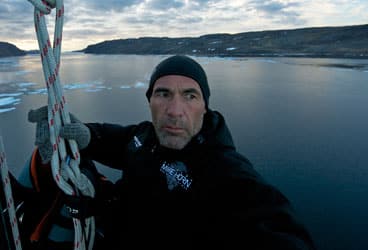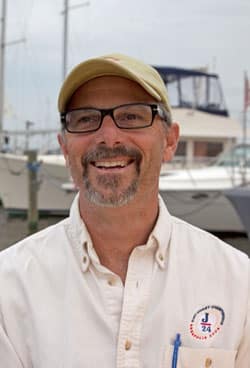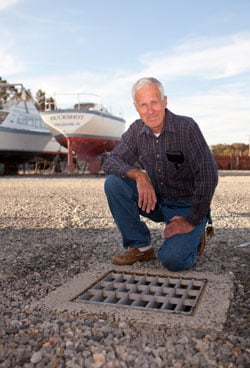
Mike Horn
Mike Horn: Tap the Energy of Youth
The idea came to him in the high northern latitudes, on a lonely trek across Alaska, Canada, Siberia, and Greenland. For Mike Horn, a lifelong adventurer whose epic voyages and expeditions have literally taken him to the very ends of Earth, his solo, two-year circumnavigation of the Arctic Circle gave him plenty of time to ponder the state of the planet and to reflect on where he’d been and what he’d seen. The thoughts, at first unsettling, were ultimately inspirational.
“After years of crossing oceans and deserts, of climbing mountains and going to the poles, I decided to share my knowledge about the elements with the younger generation,” he said last September when he arrived in Boston after he’d completed a successful transit of the Northwest Passage.
“To do it properly,” he continued, “I’d need a base of operations that could take me anywhere in the world, up rivers, across the seas, into the ice. A vessel that would go wherever I pointed my finger on a map.”
Both the vessel and the expedition Horn dreamed of—both named for the hypothetical supercontinent of eons past, Pangaea, or “one world”—came to life three years ago. Horn built the boat far from the coast in a Brazilian slum, where he spent time teaching the locals welding and carpentry skills and crafted his 105-foot, state-of-the-art “workboat” of aluminum and other recyclable materials.
Since Pangaea‘s launch, the 46-year-old Horn and his rotating international crew of Young Explorers, ranging in age from 15 to 22, have covered over 120,000 nautical miles and undertaken nine major projects, from tagging endangered polar bears in the Arctic to eradicating crown thorn starfish that were devouring coral reefs in Indonesia.
Once they’re selected for the program—aspiring Young Explorers can apply by visiting Horn’s website—Pangaea‘s youthful crewmembers, representing every continent, are put through a rigorous training regimen in Switzerland, and also receive instruction in blogging and filmmaking.
During and after their time aboard, through firsthand experience, they become journalists and activists. Horn isn’t exaggerating when he says that a stint aboard Pangaea is a “life-changing” experience.
“The problem today is that we’re losing contact with nature, forgetting its beauty and, most important, its overwhelming power,” said Horn. “People ask me about new energy sources for the future, and I always say, ‘The younger generation.’ They have untapped sources of energy. Why shouldn’t we empower the people who are going to live on this planet when you and I are no longer here? We need to invest in the youth, and in a way, that’s what I do.”
Going forward, Horn envisions a bigger Pangaea, a 200-foot catamaran aboard which he can take not a dozen but 40 Young Explorers to sea. “The idea is to finish and sustain the projects we’ve started and to get more young adults involved in new ones,” he said. “We just need more space. We’ve proven that the concept works. Now we need more projects and more ambassadors. We need to keep the momentum going. We need to make it bigger.”
– Herb McCormick

David Malkin: A Dock Project That’s Good for the Chesapeake
Sailboats and oysters have never been great bedfellows. Nobody likes to scrape the keel on a crusty old oyster bar, and the bivalves can’t like it, either. But a rare alliance has been struck at Eastport Yacht Club, in Annapolis, Maryland, where members are busy this winter planting oyster reefs under the docks.
Sailors hope the man-made reefs will stop the sea from banging their boats around when there’s big wind or powerboats passing. For the oysters, it’s a safe place to grow where Chesapeake Bay’s notoriously efficient watermen can’t catch them. And environmentalists hope the whole operation improves water quality around Maryland’s capital city.
“It’s hard to imagine oysters not growing here,” said David Malkin, who, as fleet captain, helped start the undertaking. “Even if they don’t grow, the project will make a great fish reef, and if they do grow, it’s a phenomenal win-win for everybody.”
E.Y.C. sits at the juncture of Spa Creek and the Severn River, where the fetch to the northeast is seven miles and summer boat traffic is heavy.
When the marina was expanded four years ago, a proposal to put rock walls beneath the new docks to dampen waves was rejected by state and local environmental officials worried about erosion, water-flow patterns, and stagnation. E.Y.C. went ahead without the walls, and waves have proven to be worse than expected, said Malkin, with masts clashing and people occasionally falling off boats.
Board member Kristen Robinson came up with the oyster idea. If concrete modules could be built under the docks, with channels for water to pass through, it would answer the environmental issues. And if seed oysters were planted, they could actually improve water quality.
Chesapeake oysters are in a sad state after centuries of exploitation and declining water quality. In the 1880s, more than 15 million bushels were harvested annually; these days, the catch is around 100,000 bushels. But oysters still will grow in the bay, particularly in shallow, protected waters, and wherever they grow, they provide a benefit by cleaning the water.
Many Marylanders keep oysters in floats under their private docks as a goodwill gesture, knowing that the shellfish each filter up to two gallons of bay water an hour, removing the same nutrients that feed the algae and plankton clouding the water. Oysters are like little waterborne vacuum cleaners.
With approval from state and local officials, E.Y.C. ponied up $130,000 and ordered enough modules to line the outside docks of the marina to a height of five feet. As the modules are installed, the University of Maryland’s Center for Environmental and Estuarine Studies is soaking concrete wedges in specially seeded bay water to get oyster spat started on them.
This winter, the seeded wedges will be fitted into the modules by divers.
If all goes well, the spat will grow into big, fat, nutrient-gobbling oysters within a year or two. Then comes the hard part: keeping beer-crazed mariners from slipping down and nicking a few for the shucking table.
– Angus Phillips

Harry Ruppenicker: His Battleground Is the Boatyard
Harry Ruppenicker has seen a lot of boat bottoms since his days in his boatyard in Cos Cob, Connecticut, when mercury was mixed in paint and he used a bandana to cover his face.
“It was very effective at keeping the bottom clean,” the boatyard owner says. “We didn’t know better.”
Mercury, the stuff that drove Connecticut’s hatters mad and killed World War II submariners, was beloved by sailors for the white gloss it gave paint that looked good when a boat was heeled over. It was still in use in 1961 on Long Island Sound when Ruppenicker opened his yard.
Half a century later, mercury is history, tin is banned, and copper is fixed in the crosshairs. But at Harry’s Marine Repair, now situated in Westbrook, Connecticut, on the Patchogue River, the copper residue is long gone. Five years ago, his boatyard became the first in Connecticut, and perhaps the United States, to stop using copper antifouling paints.
“In 1993 we noticed people sanding bottoms, with dust and paint going over the ground and into the air. I felt it wasn’t healthy for people here, or people working for me, and it made a mess,” Ruppenicker says.
He bought two large sanders that collect 98 percent of the dust, installed filter fabrics to collect residue on the ground, and graded the yard to raise the edges and drain to the middle, where he installed a filter. With more research, he decided that copper, a toxic heavy metal, “was bad,” and he turned to bottom paints made by ePaint, a small Massachusetts company that, with U.S. Navy underwriting, created the first non-copper anti-fouling paint. (See “Phasing Out Copper Bottom Paint.”)
The paints use a variety of pesticides to ward off fouling, including zinc pyrithione, a compound used in dandruff shampoos. They also employ a chemical reaction triggered by sunlight that creates hydrogen peroxide and deters barnacles, according to Mike Goodwin, a senior staff scientist for ePaint.
The result today is that Harry’s boatyard runoff, even though zinc is present, can drain into the river and Long Island Sound without treatment. Under state regulations that took effect at the end of 2010, all Connecticut boatyards must meet Environmental Protection Agency standards for copper runoff, which will require them either to install treatment plants or to haul wash water away.
Harry’s switch away from copper paint also means that he can dredge the channels to his marina without special permits and expense. Tests using living insects placed in the water show that 100 percent of them survive and propagate, says Ruppenicker.
“In fact, we discovered that Harry’s wash water met drinking-water standards,” says ePaint’s Goodwin.
Ruppenicker says he lost only one customer who didn’t want to make the switch. To sweeten his rule, he discounts his ePaint to $165 a gallon, a price that’s lower than some of the more reputable copper paints. “The little bit you make on the paint—it’s cheaper in the long run,” he says.
Working with the Connecticut Department of Environmental Protection, which awarded Harry’s Marine Repair its first Clean Marina Award in 2003, Ruppenicker continues to make innovations. He’s now testing a strainer with microbes “that will eat hydrocarbons and other stuff.”
– Jim Carrier
Do you know someone who’s making a difference? Learn about our Green Wakes program!








